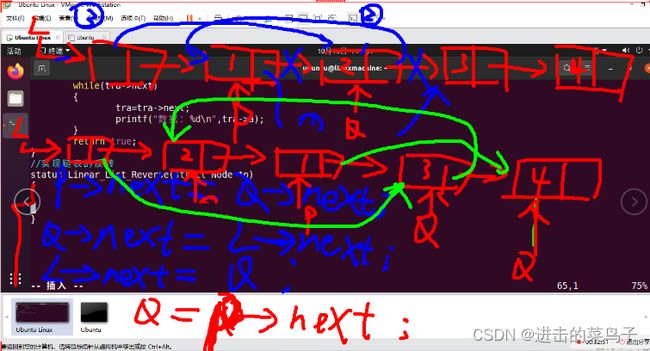- windows 安装 wsl
开启虚拟机平台和相关服务控制面板→程序→启用或关闭Windows功能确认勾选:WindowsSubsystemforLinux(适用于LInux的Windows子系统)Hyper-Vwindows虚拟机监控程序平台电脑重启打开microftstore搜索ubuntu,安装Ubuntu24.04.1LTS用管理员权限打开PowerShellwsl--update更新好后,开始菜单中打开Ubuntu2
- linux安装java jdk17 ng
1、下载jdk包wget--header=“Cookie:oraclelicense=accept-securebackup-cookie”https://download.oracle.com/java/17/archive/jdk-17.0.10_linux-x64_bin.tar.gz2、解压jdk包:tar-zxvfjdk-17.0.10_linux-x64_bin.tar.gz3、编辑配
- mobaxterm终端sqlplus乱码问题解决
胡斌附体
数据库sqlplus字符集设置乱码
背景。使用mobaxterm终端连接linux。在查询数据库表注释时发现**?**中文乱码。影响对表的分析。完成以下三个编码设置再打开sqlplus查询含中文的数据就正常了总结。需要查看sqlplus的编码是什么SELECTparameter,valueFROMnls_database_parametersWHEREparameterIN('NLS_CHARACTERSET','NLS_NCHAR
- Linux下安装Java运行环境
等木鱼的猫
javalinux服务器jdk
1.linux下载包解压yum-yinstallwgetwgethttps://repo.huaweicloud.com/java/jdk/8u201-b09/jdk-8u201-linux-x64.tar.gztar-zxvfjdk-8u201-linux-x64.tar.gzmvjdk1.8.0_201/usr/local/jdk1.8/2.配置环境变量vi/etc/profile#增加以下内
- Dify搭建私有知识库指南
挑战者666888
AI模型应用实战人工智能自然语言处理机器学习
系列文章目录CentOS系统高效部署Dify全攻略文章目录系列文章目录Dify搭建私有知识库指南一、引言二、环境准备与基础配置(含Linux命令)1.硬件要求2.软件依赖安装(Linux命令)3.安装Dify(Docker-compose部署)4.初始化设置三、数据接入与知识库构建(含实战案例)1.数据源接入示例2.数据预处理3.向量化存储配置实战案例:企业产品手册知识库四、检索与增强功能实现1.
- 在linux安装jdk,运行jar
Liang.Wang
javalinuxjar
进入/usr/local文件夹cd/usr/local执行命令创建java文件夹mkdirjava进入java文件夹cdjava执行在线下载命令wget--no-check-certificate--no-cookies--header“Cookie:oraclelicense=accept-securebackup-cookie”http://download.oracle.com/otn-pu
- Linux安装JDK详细教程
1、yum安装1.1查看JDK版本,找到你想要安装的JDK版本,这里以JDK1.8为例输入命令:yum-ylistjava*若出现以下内容:解决办法:在安装完CentOS后一般需要修改yum源,才能够在安装更新rpm包时获得比较理想的速度。cd/etc/yum.repos.d备份原始的yum源配置文件在CentOS7系统中,yum源的主要配置文件是/etc/yum.repos.d/CentOS-B
- Map和Set
爱吃小土豆豆豆豆
java开发语言
Map和Set概念:Map和set是一种专门用来进行搜索的容器或者数据结构,其搜索的效率与其具体的实例化子类有关。以前常见的搜索方式有:直接遍历,时间复杂度为O(N),元素如果比较多效率会非常慢二分查找,时间复杂度为,但搜索前必须要求序列是有序的上述排序比较适合静态类型的查找,即一般不会对区间进行插入和删除操作了,而现实中的查找比如:根据姓名查询考试成绩通讯录,即根据姓名查询联系方式不重复集合,即
- 2025年Java后端开发岗面试的高频项目场景题 + 八股文(100w字)
小凡敲代码
javajava面试java八股文Java场景题程序员计算机Java面试题
一、Java八股文高频面试题1.Java基础HashMapvsConcurrentHashMapHashMap:非线程安全,JDK1.8后采用数组+链表/红黑树,扩容时可能死循环(JDK1.7)。ConcurrentHashMap:JDK1.7用分段锁,JDK1.8改用CAS+synchronized优化锁粒度。synchronizedvsReentrantLocksynchronized:JVM
- 真题训练1-算法思维训练
不懂的浪漫
数据结构与算法算法题
真题训练1-算法思维训练文章目录真题训练1-算法思维训练前言项目环境例题1:斐波那契数列例题2:判断一个数组中是否存在某个数参考前言第十四章《通用解题的方法论》我们讨论了解题的方法论,宏观上可以分为以下4个步骤:复杂度分析,估算问题中的复杂度的上限和下限。定位问题,根据问题类型,确定采用何种算法思维。数据操作分析,根据增、删、查和数据顺序关系选择合适的数据结构,利用空间换时间的思想。编码实现。本章
- 最新最全的阿里云服务器部署Django项目教程(2021)
阿里云Linux服务器以Nginx+uWSGI部署Django项目教程前言:本教程适用于以Windows和Linux系统环境开发Django项目的初学者,帮助其将第一个Django项目部署上线,同时包含了一部分的DeBug方案,供其参考。-作者本地环境是Django2.0+Python3.8.3+Sqlite,以virtualenv在本地建立的虚拟环境。-作者Web代理服务器使用的是uWSGI,反
- 【宝塔Linux面板】在阿里云服务器安装
孤独本就常态
linux运维阿里云
文章目录一、宝塔Linux面板是什么?二、宝塔Linux面板安装步骤1.下载Xshell2.远程连接服务器3.进入宝塔官网4.安装面板5.安装成功三、总结一、宝塔Linux面板是什么?宝塔Linux面板是提升运维效率的服务器管理软件,支持一键LAMP/LNMP/集群/监控/网站/FTP/数据库/JAVA等100多项服务器管理功能。有30个人的专业团队研发及维护,经过200多个版本的迭代,功能全,少
- vue中添加原生右键菜单
叹一曲当时只道是寻常
vue.jsjavascript
数据结构定义conststate=reactive({contextMenu:{visible:false,x:0,y:0,currentItem:null}});//新增右键菜单处理函数consthandleContextMenu=(event,item)=>{event.preventDefault();state.contextMenu={visible:true,x:event.clien
- Buildroot,Debian 和 Ubuntu 有什么差别
科学的发展-只不过是读大自然写的代码
驱动开发debianubuntu运维
Buildroot、Debian和Ubuntu都是流行的Linux发行版或构建系统,但它们在目标、使用方式和结构上有所不同。以下是它们之间的主要差别:Buildroot:Buildroot是一个为嵌入式Linux系统提供完全自动化构建的工具。它不是一个常规的Linux发行版,而是一个用于构建自定义Linux系统的工具集。使用Buildroot,你可以从零开始构建一个定制的Linux系统,包括内核、
- Firefox部分网页不能输入中文
两斤半
Ubuntuubuntufirefox
Linux客户端使用Fcitx5输入法时暂时关闭输入法的预编辑功能,快捷键(Ctrl+Alt+P)Windows端使用微软输入法(输不了中文时)常规-兼容性-使用以前版本的微软输入法(开启)
- Android-NDK的linux交叉编译环境
qq_33955482
嵌入式Androidandroid
NDK工具包下载NDK下载|AndroidNDK|AndroidDevelopershttps://github.com/android/ndk/wiki/Unsupported-Downloads以android-ndk-r26c下载为例,下载后将压缩包解压至/usr目录下CMakeLists编译选项设置编译平台变量判断条件中增加一下android条件下CMake的变量CMAKE_MINIMUM
- Buildroot,Ubuntu,Debian,Yocto 它们分别是什么,它们之间的具体关系是什么
玄奕子
嵌入式学习之Linux入门篇ubuntudebianlinuxBuildrootYocto
1.Buildroot定义:Buildroot是一个简化和加速嵌入式Linux系统开发过程的工具,提供一种容易、高效的方式来生成交叉编译工具链、根文件系统、内核映像和引导加载程序。Buildroot使用makefile和kconfig(和Linux内核使用的相同系统)来配置和构建整个嵌入式系统。适用场景:对于需要轻量级或高度定制的嵌入式系统,Buildroot非常适合,尤其是那些资源受限或对启动时
- 应急响应靶机-Linux(2)
满心欢喜love
linux运维服务器
前言本次应急响应靶机采用的是知攻善防实验室的Linux-2应急响应靶机靶机下载地址为:https://pan.quark.cn/s/4b6dffd0c51a相关账户密码:root/Inch@957821.(记住要带最后的点.)解题启动靶机不建议直接使用账号密码登录,建议用另一台主机通过ssh协议连接该靶机。我这里是用kalissh连接该靶机第一题、攻击者IP想要知道攻击者的ip地址,那肯定是要去看
- DAY08 算法训练营| 字符串part01
天空的孩子
算法
344.反转字符串-力扣(LeetCode)字符串和数组算法题目思路类似反转字符串是经典双指针法(回忆反转链表,有序数组的平方,三数之和,四数之和)classSolution{public:voidreverseString(vector&s){len=s.length();for(inti=0,j=s.size()-1;iusingnamespacestd;intmain(){strings;/
- Linux Docker 防火墙设置 放通 MySQL(3306) Redis(6379) 端口
LinuxDocker防火墙设置放通MySQL(3306)Redis(6379)端口,使用firewalld防火墙或iptables,因此尝试重新启动firewalld服务,添加防火墙规则,并检查防火墙状态。以下是详细步骤:1.启动firewalld服务首先启动firewalld服务:sudosystemctlstartfirewalldsudosystemctlenablefirewalld2.
- 如何在Ubuntu上检查MySQL是否启动并放开3306端口
好奇的菜鸟
服务器数据库ubuntumysqladb
在使用Ubuntu系统时,MySQL数据库是许多开发人员和系统管理员的常用工具。本文将详细介绍如何在Ubuntu上检查MySQL是否启动,以及如何放开MySQL默认的3306端口,以便允许外部访问。一、检查MySQL是否启动在进行任何操作之前,首先需要确认MySQL服务是否已经启动。以下是几种检查MySQL是否启动的方法:1.使用systemctl命令systemctl是Linux系统中用于管理服
- 【网络】Linux 内核优化实战 - net.ipv4.tcp_timestamps
锅锅来了
Linux性能优化原理和实战网络tcp/iplinux
目录`net.ipv4.tcp_timestamps`详解1.功能与作用2.参数取值与含义3.启用/禁用的影响4.配置方法5.适用场景建议6.注意事项总结net.ipv4.tcp_timestamps详解net.ipv4.tcp_timestamps是Linux内核中一个与TCP协议相关的网络参数,用于控制是否启用TCP时间戳选项(TCPTimestampsOption)。该选项在RFC1323中
- 内核高性能-熟悉内核性能相关的配置相关参数解析
jxusthusiwen
linux开发语言c语言
内核高性能-熟悉内核性能相关的配置相关参数解析目录内核高性能-熟悉内核性能相关的配置相关参数解析(1)Linux各个用户文件打开数/etc/security/limits.conf(2)Linux系统文件打开数/proc/sys/fs/file-max(3)内核主要配置文件/etc/sysctl.conf(4)测试机器配置cat/etc/sysctl.conf|grep-v"#"(5)/proc/
- 【Note】《深入理解Linux内核》Chapter 14 :深入理解 Linux 块设备驱动程序
CodeWithMe
读书笔记linuxlinux运维服务器
《深入理解Linux内核》Chapter14:深入理解Linux块设备驱动程序关键词:块设备、gendisk、请求队列、requestqueue、bio、pagecache、I/O调度器、通用块层、文件系统、磁盘管理一、块设备简介与特性1.1块设备定义块设备是可以被分成固定大小块(通常为512字节或4KB)进行读写的设备。与字符设备不同,块设备支持随机访问和缓存,是构建文件系统的基础。1.2典型块
- C语言--- 指针运算笔试题详解
星纭
Cc语言算法开发语言
目录题目1:题目2:题目3:题目4:题目5:题目6:题目7:题目1:#includeintmain(){inta[5]={1,2,3,4,5};int*ptr=(int*)(&a+1);printf("%d,%d",*(a+1),*(ptr-1));return0;}解析:a是数组首元素的地址,类型为int*,+1跳过一个元素,再解引用就是第二个元素。&a是整个数组的地址,+1跳过整个数组,再强制
- Linux内核深度解析:IPv4策略路由的核心实现与fib_rules.c源码剖析
109702008
编程#C语言网络linux网络人工智能
深入探索Linux网络栈的规则引擎,揭秘策略路由如何通过多级路由表实现复杂流量控制在Linux网络栈中,路由决策远不止简单的目的地址匹配。策略路由(PolicyRouting)允许根据源地址、TOS值、端口等复杂条件选择不同的路由路径。本文将深入剖析实现这一功能的核心源码——net/ipv4/fib_rules.c,揭示策略路由的运作机制。一、策略路由基础概念策略路由打破了传统路由基于单一目的地址
- 大数据分析技术的学习路径,不是绝对的,仅供参考
水云桐程序员
学习大数据数据分析学习方法
阶段一:基础筑基(1-3个月)1.编程语言:Python:掌握基础语法、数据结构、流程控制、函数、面向对象编程、常用库(NumPy,Pandas)。SQL:精通SELECT语句(过滤、排序、分组、聚合、连接)、DDL/DML基础。理解关系型数据库概念(表、主键、外键、索引)。MySQL或PostgreSQL是很好的起点。Java/Scala:深入理解Hadoop/Spark等框架会更有优势。初学者
- CMake学习笔记
Ethan@LM
学习笔记c++
第1章cmake的基础命令1.1基础命令cmake-S-B-S:指定源码目录(CMakeLists.txt所在目录)。-B:指定构建目录(即输出目录)。1.2指定编译器和编译选项-DCMAKE_C_COMPILER=设置C语言编译器的路径。-DCMAKE_CXX_COMPILER=设置C++编译器的路径。-DCMAKE_C_FLAGS="-g"设置C语言编译标志(例如调试信息)。-DCMAKE_C
- Linux中的挂载
假设我们有一个U盘设备,当我们将U盘挂载到/mnt/usb目录时,系统会把这个U盘文件系统中的内容与/mnt/usb关联起来,之后我们只需进入/mnt/usb,就能看到U盘中的所有文件。挂载前:/mnt/usb目录是空的。挂载后:/mnt/usb目录中显示的是U盘的文件内容。步骤1:插入U盘首先,将U盘插入计算机的USB端口。Linux系统通常会自动检测到新设备,但我们需要手动挂载以便访问U盘内容
- python编程语言自我介绍_编程语言拟人:来自Python、JAVA、C语言的“傲娇”自我介绍!...
weixin_39865061
python编程语言自我介绍
软件工程领域,酷爱编程的人很多,但另一些人总是对此避之不及。而构建软件无疑会让所有人压力山大,叫苦连连。来看看这些流行编程语言的“内心独白”,JAVA现实,C++傲娇,Rust充满安全感,COBOL紧跟时事不掉队……让人头大的编程看起来是不是可爱些了。本文没有冒犯的意思,毕竟幽默有助于建立联系,只希望能博君一笑。Python我们能像模像样写出伪代码,即使您不理解它。不用依靠分号或中括号,区区空格就
- Nginx负载均衡
510888780
nginx应用服务器
Nginx负载均衡一些基础知识:
nginx 的 upstream目前支持 4 种方式的分配
1)、轮询(默认)
每个请求按时间顺序逐一分配到不同的后端服务器,如果后端服务器down掉,能自动剔除。
2)、weight
指定轮询几率,weight和访问比率成正比
- RedHat 6.4 安装 rabbitmq
bylijinnan
erlangrabbitmqredhat
在 linux 下安装软件就是折腾,首先是测试机不能上外网要找运维开通,开通后发现测试机的 yum 不能使用于是又要配置 yum 源,最后安装 rabbitmq 时也尝试了两种方法最后才安装成功
机器版本:
[root@redhat1 rabbitmq]# lsb_release
LSB Version: :base-4.0-amd64:base-4.0-noarch:core
- FilenameUtils工具类
eksliang
FilenameUtilscommon-io
转载请出自出处:http://eksliang.iteye.com/blog/2217081 一、概述
这是一个Java操作文件的常用库,是Apache对java的IO包的封装,这里面有两个非常核心的类FilenameUtils跟FileUtils,其中FilenameUtils是对文件名操作的封装;FileUtils是文件封装,开发中对文件的操作,几乎都可以在这个框架里面找到。 非常的好用。
- xml文件解析SAX
不懂事的小屁孩
xml
xml文件解析:xml文件解析有四种方式,
1.DOM生成和解析XML文档(SAX是基于事件流的解析)
2.SAX生成和解析XML文档(基于XML文档树结构的解析)
3.DOM4J生成和解析XML文档
4.JDOM生成和解析XML
本文章用第一种方法进行解析,使用android常用的DefaultHandler
import org.xml.sax.Attributes;
- 通过定时任务执行mysql的定期删除和新建分区,此处是按日分区
酷的飞上天空
mysql
使用python脚本作为命令脚本,linux的定时任务来每天定时执行
#!/usr/bin/python
# -*- coding: utf8 -*-
import pymysql
import datetime
import calendar
#要分区的表
table_name = 'my_table'
#连接数据库的信息
host,user,passwd,db =
- 如何搭建数据湖架构?听听专家的意见
蓝儿唯美
架构
Edo Interactive在几年前遇到一个大问题:公司使用交易数据来帮助零售商和餐馆进行个性化促销,但其数据仓库没有足够时间去处理所有的信用卡和借记卡交易数据
“我们要花费27小时来处理每日的数据量,”Edo主管基础设施和信息系统的高级副总裁Tim Garnto说道:“所以在2013年,我们放弃了现有的基于PostgreSQL的关系型数据库系统,使用了Hadoop集群作为公司的数
- spring学习——控制反转与依赖注入
a-john
spring
控制反转(Inversion of Control,英文缩写为IoC)是一个重要的面向对象编程的法则来削减计算机程序的耦合问题,也是轻量级的Spring框架的核心。 控制反转一般分为两种类型,依赖注入(Dependency Injection,简称DI)和依赖查找(Dependency Lookup)。依赖注入应用比较广泛。
- 用spool+unixshell生成文本文件的方法
aijuans
xshell
例如我们把scott.dept表生成文本文件的语句写成dept.sql,内容如下:
set pages 50000;
set lines 200;
set trims on;
set heading off;
spool /oracle_backup/log/test/dept.lst;
select deptno||','||dname||','||loc
- 1、基础--名词解析(OOA/OOD/OOP)
asia007
学习基础知识
OOA:Object-Oriented Analysis(面向对象分析方法)
是在一个系统的开发过程中进行了系统业务调查以后,按照面向对象的思想来分析问题。OOA与结构化分析有较大的区别。OOA所强调的是在系统调查资料的基础上,针对OO方法所需要的素材进行的归类分析和整理,而不是对管理业务现状和方法的分析。
OOA(面向对象的分析)模型由5个层次(主题层、对象类层、结构层、属性层和服务层)
- 浅谈java转成json编码格式技术
百合不是茶
json编码java转成json编码
json编码;是一个轻量级的数据存储和传输的语言
在java中需要引入json相关的包,引包方式在工程的lib下就可以了
JSON与JAVA数据的转换(JSON 即 JavaScript Object Natation,它是一种轻量级的数据交换格式,非
常适合于服务器与 JavaScript 之间的数据的交
- web.xml之Spring配置(基于Spring+Struts+Ibatis)
bijian1013
javaweb.xmlSSIspring配置
指定Spring配置文件位置
<context-param>
<param-name>contextConfigLocation</param-name>
<param-value>
/WEB-INF/spring-dao-bean.xml,/WEB-INF/spring-resources.xml,
/WEB-INF/
- Installing SonarQube(Fail to download libraries from server)
sunjing
InstallSonar
1. Download and unzip the SonarQube distribution
2. Starting the Web Server
The default port is "9000" and the context path is "/". These values can be changed in &l
- 【MongoDB学习笔记十一】Mongo副本集基本的增删查
bit1129
mongodb
一、创建复本集
假设mongod,mongo已经配置在系统路径变量上,启动三个命令行窗口,分别执行如下命令:
mongod --port 27017 --dbpath data1 --replSet rs0
mongod --port 27018 --dbpath data2 --replSet rs0
mongod --port 27019 -
- Anychart图表系列二之执行Flash和HTML5渲染
白糖_
Flash
今天介绍Anychart的Flash和HTML5渲染功能
HTML5
Anychart从6.0第一个版本起,已经逐渐开始支持各种图的HTML5渲染效果了,也就是说即使你没有安装Flash插件,只要浏览器支持HTML5,也能看到Anychart的图形(不过这些是需要做一些配置的)。
这里要提醒下大家,Anychart6.0版本对HTML5的支持还不算很成熟,目前还处于
- Laravel版本更新异常4.2.8-> 4.2.9 Declaration of ... CompilerEngine ... should be compa
bozch
laravel
昨天在为了把laravel升级到最新的版本,突然之间就出现了如下错误:
ErrorException thrown with message "Declaration of Illuminate\View\Engines\CompilerEngine::handleViewException() should be compatible with Illuminate\View\Eng
- 编程之美-NIM游戏分析-石头总数为奇数时如何保证先动手者必胜
bylijinnan
编程之美
import java.util.Arrays;
import java.util.Random;
public class Nim {
/**编程之美 NIM游戏分析
问题:
有N块石头和两个玩家A和B,玩家A先将石头随机分成若干堆,然后按照BABA...的顺序不断轮流取石头,
能将剩下的石头一次取光的玩家获胜,每次取石头时,每个玩家只能从若干堆石头中任选一堆,
- lunce创建索引及简单查询
chengxuyuancsdn
查询创建索引lunce
import java.io.File;
import java.io.IOException;
import org.apache.lucene.analysis.Analyzer;
import org.apache.lucene.analysis.standard.StandardAnalyzer;
import org.apache.lucene.document.Docume
- [IT与投资]坚持独立自主的研究核心技术
comsci
it
和别人合作开发某项产品....如果互相之间的技术水平不同,那么这种合作很难进行,一般都会成为强者控制弱者的方法和手段.....
所以弱者,在遇到技术难题的时候,最好不要一开始就去寻求强者的帮助,因为在我们这颗星球上,生物都有一种控制其
- flashback transaction闪回事务查询
daizj
oraclesql闪回事务
闪回事务查询有别于闪回查询的特点有以下3个:
(1)其正常工作不但需要利用撤销数据,还需要事先启用最小补充日志。
(2)返回的结果不是以前的“旧”数据,而是能够将当前数据修改为以前的样子的撤销SQL(Undo SQL)语句。
(3)集中地在名为flashback_transaction_query表上查询,而不是在各个表上通过“as of”或“vers
- Java I/O之FilenameFilter类列举出指定路径下某个扩展名的文件
游其是你
FilenameFilter
这是一个FilenameFilter类用法的例子,实现的列举出“c:\\folder“路径下所有以“.jpg”扩展名的文件。 1 2 3 4 5 6 7 8 9 10 11 12 13 14 15 16 17 18 19 20 21 22 23 24 25 26 27 28
- C语言学习五函数,函数的前置声明以及如何在软件开发中合理的设计函数来解决实际问题
dcj3sjt126com
c
# include <stdio.h>
int f(void) //括号中的void表示该函数不能接受数据,int表示返回的类型为int类型
{
return 10; //向主调函数返回10
}
void g(void) //函数名前面的void表示该函数没有返回值
{
//return 10; //error 与第8行行首的void相矛盾
}
in
- 今天在测试环境使用yum安装,遇到一个问题: Error: Cannot retrieve metalink for repository: epel. Pl
dcj3sjt126com
centos
今天在测试环境使用yum安装,遇到一个问题:
Error: Cannot retrieve metalink for repository: epel. Please verify its path and try again
处理很简单,修改文件“/etc/yum.repos.d/epel.repo”, 将baseurl的注释取消, mirrorlist注释掉。即可。
&n
- 单例模式
shuizhaosi888
单例模式
单例模式 懒汉式
public class RunMain {
/**
* 私有构造
*/
private RunMain() {
}
/**
* 内部类,用于占位,只有
*/
private static class SingletonRunMain {
priv
- Spring Security(09)——Filter
234390216
Spring Security
Filter
目录
1.1 Filter顺序
1.2 添加Filter到FilterChain
1.3 DelegatingFilterProxy
1.4 FilterChainProxy
1.5
- 公司项目NODEJS实践0.1
逐行分析JS源代码
mongodbnginxubuntunodejs
一、前言
前端如何独立用nodeJs实现一个简单的注册、登录功能,是不是只用nodejs+sql就可以了?其实是可以实现,但离实际应用还有距离,那要怎么做才是实际可用的。
网上有很多nod
- java.lang.Math
liuhaibo_ljf
javaMathlang
System.out.println(Math.PI);
System.out.println(Math.abs(1.2));
System.out.println(Math.abs(1.2));
System.out.println(Math.abs(1));
System.out.println(Math.abs(111111111));
System.out.println(Mat
- linux下时间同步
nonobaba
ntp
今天在linux下做hbase集群的时候,发现hmaster启动成功了,但是用hbase命令进入shell的时候报了一个错误 PleaseHoldException: Master is initializing,查看了日志,大致意思是说master和slave时间不同步,没办法,只好找一种手动同步一下,后来发现一共部署了10来台机器,手动同步偏差又比较大,所以还是从网上找现成的解决方
- ZooKeeper3.4.6的集群部署
roadrunners
zookeeper集群部署
ZooKeeper是Apache的一个开源项目,在分布式服务中应用比较广泛。它主要用来解决分布式应用中经常遇到的一些数据管理问题,如:统一命名服务、状态同步、集群管理、配置文件管理、同步锁、队列等。这里主要讲集群中ZooKeeper的部署。
1、准备工作
我们准备3台机器做ZooKeeper集群,分别在3台机器上创建ZooKeeper需要的目录。
数据存储目录
- Java高效读取大文件
tomcat_oracle
java
读取文件行的标准方式是在内存中读取,Guava 和Apache Commons IO都提供了如下所示快速读取文件行的方法: Files.readLines(new File(path), Charsets.UTF_8); FileUtils.readLines(new File(path)); 这种方法带来的问题是文件的所有行都被存放在内存中,当文件足够大时很快就会导致
- 微信支付api返回的xml转换为Map的方法
xu3508620
xmlmap微信api
举例如下:
<xml>
<return_code><![CDATA[SUCCESS]]></return_code>
<return_msg><![CDATA[OK]]></return_msg>
<appid><
